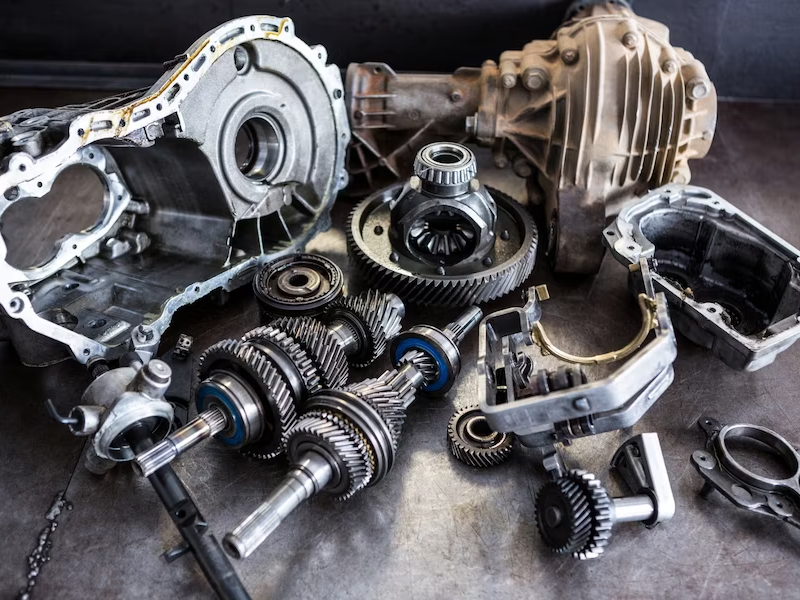In the ever-evolving world of agriculture, modern farm machinery plays a crucial role in enhancing productivity and efficient crop management. This article provides an overview of various farm machines with names, shedding light on their functional capabilities and benefits.
From time-saving tractors to versatile combines, we explore the latest advancements in agricultural technology that empower farmers to make informed decisions, increasing productivity and effectiveness.
What Machines Are Used on a Farm?
To efficiently tackle various tasks on farms, a wide range of machines and agricultural equipment comes into play.
Some commonly used machines on farms include:
- Tractors: Versatile machines used for plowing, soil cultivation, planting, harvesting, and transporting goods, forming the backbone of modern agriculture;
- Combines: Specialized machines designed for efficient harvesting of grains, fruits, and vegetables during the harvest season;
- Seeders/Planters: These machines ensure precise and uniform seed placement during planting, leading to optimal growth and crop yield;
- Irrigation Systems: Including sprinklers, drip irrigation, and pivot systems, they deliver water to crops to maintain the required moisture level;
- Sprayers: Used for applying fertilizers, pesticides, and herbicides, protecting crops from pests and diseases, and promoting healthy growth;
- Cultivators: Preparing the soil for planting by breaking clods, removing weeds, and improving soil structure;
- Balers: Utilized to compress and bind hay, straw, and other crops into bales for convenient storage and transportation;
- Milking Machines: Automated devices used in dairy farms to streamline the milking process, enhance efficiency, and ensure hygienic milk production;
- Livestock Feeders: Automated feed distributors provide animals with nutritious feed, ensuring their well-being and reducing manual labor;
- Grain Dryers: Designed to remove excess moisture from harvested grain, preserving its quality during storage;
- Mowers: Used to cut grass, hay, or other crops for fodder or silage;
- Plows: Employed for turning over the soil to prepare it for planting and burying plant residues.
These machines and equipment significantly contribute to modern agricultural practices, boosting productivity, efficiency, and sustainable development.
Revolutionizing Farming with Advanced Machinery
Over the years, significant changes have occurred in agriculture, and at the heart of these changes lies agricultural machinery.

These specialized machines have revolutionized farming, optimizing various tasks such as soil preparation, planting, cultivation, and harvesting:
- Universal Tractors: Tractors are the backbone of modern agriculture. Evolving from simple workhorses to complex machines equipped with cutting-edge technology and attachments, tractors perform a wide range of tasks, including plowing, soil cultivation, planting, and transportation. This allows farmers to optimize their land management and increase labor productivity;
- Precision Seeders and Planters: Precision seeders and planters have transformed the way agricultural crops are sown. Utilizing advanced technologies and GPS integration, these machines ensure accurate seed placement, spacing, and seeding depth, resulting in uniform emergence and improved yields. Precise planting also reduces seed losses and promotes efficient resource utilization;
- Combines: Combines have redefined the concept of the harvest season, automating the process of efficient crop harvesting and reducing labor requirements. Specialized combines cater to different crops, from grains and fruits to vegetables and sugarcane, optimizing the harvesting process and preserving crop quality;
- Sprayers and Irrigation Systems: Sprayers and irrigation systems play a crucial role in protecting crops from pests and diseases while ensuring sufficient water supply. Modern sprayers provide precise application of fertilizers, reducing chemical usage and environmental impact. Irrigation systems, including drip irrigation and pivot systems, optimize water distribution, preserving this valuable resource;
- Agricultural Robots and Autonomous Vehicles: The advent of agrarian robots and autonomous vehicles has brought innovation to farming. These machines perform tasks such as weeding, crop monitoring, and even harvesting, reducing the need for manual labor and enabling farmers to efficiently manage vast fields;
- Livestock Handling Equipment: Agricultural technology goes beyond cultivating crops; it also aids in livestock management. Livestock handling equipment, like cattle crushers and sheep handlers, improves animal welfare and enhances operations such as weighing, tagging, and medical examinations;
- Environmental Impact and Sustainable Development: Agricultural machinery significantly influences the sustainability of farming. Advanced technologies used in these machines help reduce chemical use, water losses, and soil erosion. Additionally, precise farming with agricultural machinery allows more efficient resource utilization, contributing to sustainable agricultural practices.
Despite numerous advantages, agricultural machines face challenges like high initial costs, accessibility in remote areas, and potential environmental issues. Addressing these problems requires ongoing research and development to make these technologies more accessible, affordable, and eco-friendly.
The future of agricultural machinery lies in integrating artificial intelligence, big data, and robotics, leading to more intelligent and autonomous farming methods.
Tractor Attachments
Tractors serve as the workhorses of modern agriculture, but their true potential is unleashed through a vast array of tractor attachments. These versatile add-ons have revolutionized farming by enabling farmers to efficiently handle a wide range of tasks, from soil preparation to crop care and harvesting:
- Plows and Cultivators: Plows and cultivators are vital tractor attachments used for soil preparation. Plows are ideal for breaking and turning the soil, while cultivators finely pulverize the ground, creating a smooth seedbed for planting. These implements ensure optimal soil conditions, promoting healthy root growth, and increasing crop yields;
- Seeders and Planters: Seeders and planters are high-precision tractor attachments designed to ensure accurate and uniform seed placement. Utilizing advanced technologies and GPS navigation, they optimize seed spacing and seeding depth, reducing seed losses and promoting even emergence;
- Cultivators: Cultivators are versatile attachments used for weed control and secondary soil cultivation. They break up soil clumps, remove weeds, and aerate the soil, creating favorable conditions for crop growth. Cultivators come in various designs, allowing farmers to adapt to specific crop and soil requirements;
- Harrows: Harrows are attachments used for final seedbed preparation, leveling the soil, and breaking up large clods after plowing or cultivation. They provide a smooth and even surface for planting, leading to better seed-to-soil contact and improved germination;
- Mowers and Flail Mowers: Mowers and flail mowers are tractor attachments used for cutting grass, hay, or crop residues. They are essential for fodder production, enabling farmers to harvest feed for livestock or prepare fields for subsequent planting;
- Sprayers: Sprayers are vital tractor attachments for crop protection. They evenly distribute pesticides, herbicides, and fertilizers across the field, safeguarding crops from pests and diseases and optimizing resource utilization;
- Front Loaders and Buckets: Front loaders and buckets add versatility to tractors, allowing them to perform a wide range of tasks beyond traditional fieldwork. From material handling and loading to barn cleaning and moving heavy objects, these attachments provide invaluable assistance on the farm;
- Bale Loaders: Bale loaders facilitate the movement and transportation of hay and straw bales. These devices come in various designs and enable farmers to efficiently handle and store bales, reducing losses and saving time during feeding;
- Cultivators: Cultivators are powerful attachments used for deep soil cultivation. They break compacted soil layers, improving water infiltration and root penetration, and ultimately enhancing soil structure and fertility;
- Soil Hole Diggers: Soil hole diggers are used for fence installation and planting trees and shrubs. These attachments create precise and uniform holes in the ground, simplifying fence installation and landscaping tasks.
Tractor attachments form the foundation of versatility and efficiency in agricultural production. Expanding a tractor’s capabilities, these attachments allow farmers to tackle a multitude of tasks – from soil preparation and planting to crop care and harvest.
Integrating advanced technologies into modern tractor attachments enhances precision and optimizes resource utilization, promoting sustainable agricultural practices. As agriculture continues to evolve, tractor attachments will remain indispensable tools, enabling farmers to address the challenges of providing food for a growing global population while preserving valuable natural resources.
Conclusions
Agricultural machines have transformed agriculture, providing farmers with tools to optimize productivity, reduce labor, and implement sustainable practices. From tractors to precision seeders, combines, and innovative technologies – these machines continue to revolutionize agriculture.
As we progress towards a more eco-friendly and sustainable future, investments in research and development, as well as the implementation of intelligent farming methods, will play a key role in further expanding the capabilities of agricultural machinery and ensuring food security for future generations.



